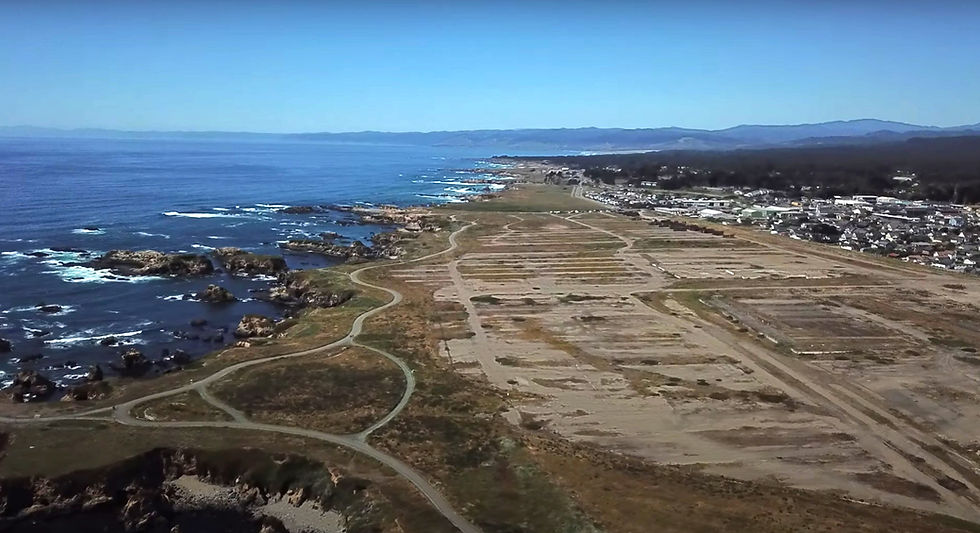Grass Roots Institute Considers Noyo Harbor and Other Issues
- grassrootsinstitut
- Jan 30, 2023
- 4 min read
Updated: Jan 31, 2023
Noyo Harbormaster Anna Neumann spoke at the monthly meeting of the GrassRoots Institute (GRI) on Jan. 22 at the Caspar Community Center. Anna, who studied oceanography at Humboldt State (now Cal Poly Humboldt), earned a Master’s Degree in marine ecosystems there, and engaged in commercial fishing in Noyo Harbor along the way, was named Harbormaster in September of 2021. The Harbor District is in charge of the mooring basin, the marina, and the mud underlying commercial establishments in the harbor, and rents mooring slips both to transient and long-term boats. Besides helping the district to maintain its facilities in working condition, she sees her role as learning how the harbor can change and develop as new industries develop there.

The Community Sustainability Plan, published in 2019 gives her a convenient to-do list of 11 areas to guide her work. She described the three top priorities listed there—renovate and repair the existing docks, which are crucial for fishermen to do their work; develop a new fuel dock downstream from the existing one at Dolphin Isle, which will lower fuel costs for larger vessels which now depend on trucks for fueling; and develop a new refrigeration facility which would more efficiently provide necessary ice at reduced prices, making the costs at Noyo more comparable to other California ports. She hopes public/private joint ventures can be developed which could provide enough funding for the new infrastructure.
Anna illustrated the economic pressure which is forcing a decline in captains who can stay in business, by discussing the factors which affect the crab industry. Before a crab harvester can go out, certain conditions must be met—no whales in the area which could get caught up in operations; low levels of domoic acid in the ocean; sufficient protein in the body composition of the crabs; a quiet ocean (i.e. no storms); and a wholesale price sufficient to pay to cost of harvesting. This year, once all the first conditions had been met, there was no price being offered by the crab buyer. Then there was an offer of $1.89—not enough to pay the overhead. Finally there was a ‘handshake’ offer of $3.50, but only for a first quantity, not the whole harvest, a situation which fosters a frenzied race to be first to bring in the catch, and which only allows large boats to get their whole catch paid for at a sufficient price.
To a question concerning future development at the harbor, such as envisioned by the recent Blue Economy Symposium, the harbormaster said that her focus was an making the infrastructure secure enough to support the traditional industries of charter fishing, commercial fishing, and tourism (whale watching and restaurants, for example) as well as any new forms of aquaculture which may develop. She thinks the vision for creating new economies is better left to others, such as the Noyo Center for Marine Science and the Ocean Conservancy. In her view, state and federal regulations have been good for the sustainability of the marine economy—she cited the comeback of the picacho population as an example of the benefit which current policy provides. She is determined to do what she can to keep the ‘fishing village’ designation in force, so that tourism co-exists with viable commercial harvesting—a condition which benefits tourism dependent operations, as well.
The second half of the meeting was devoted to different GRI ‘working groups.’ League (of Women Voters) member Morning Nichols attended the Mendocino Vision working group, led by Peter McNamee, and sent in this report.

Peter suggested that the group shift its focus, for the time being, entirely to the upcoming Local Coastal Program updates to be conducted by Mendocino County, the city of Fort Bragg in concert with the Noyo Harbor District, and the city of Point Arena [see Midwinter ’22 Voter]. An LCP consists of 2 parts: Policies—setting general rules, purposes, and objectives; and Implementation—how the goals are to be achieved. Creating the LCP is scheduled to take approximately 4 years, a process which includes hiring various consultants, conducting studies, and taking extensive public input. There is nearly $3M in funding for the three separate updates, which, together, will cover the entire Mendocino Coast and the Noyo and Point Arena Harbors, and even more funding could be provided, should the need for it arise. The funds are from grants awarded by the Coastal Commission to plan for Climate Change Mitigation, and include money for studies of commercial and recreational fishing; deep exploration of our Coast; and the analysis of data collected. Peter suggested that Mendocino Coast will become attractive to populations who are forced to relocate from other parts of California by the sea level rise which climate change is causing. A next step will be to invite the Fort Bragg city manager to discuss the city’s LCP update plans at a public meeting. The main points of contact for LCP information are County Planning Director Julia Krog and Fort Bragg Asst. City Manager, Sarah McCormick. Anyone interested in participating in this newly focused Working Group is invited to contact Peter at pmcnamee@sbcglobal.net.
Written by Jary Stavely for the League of Women Voters Newsletter



Comments